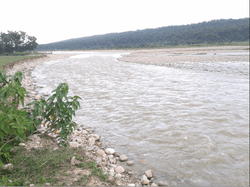Kamala River
The Kamala River (Hindi and Nepali: कमला नदी kamalā nadī) originates from Nepal and flows through Indian state of Bihar.
| Kamala River | |
|---|---|
 Kamala river near Hatpate-5, Sindhuli, Nepal | |
| Location | |
| Country | Nepal, India |
| State | Bihar |
| Physical characteristics | |
| Source | |
| • location | near Maithan, Sindhuliagadhi, Sindhuli District, Churia Range, Nepal |
| • coordinates | 27°15′N 85°57′E |
| • elevation | 1,200 m (3,900 ft) |
| Mouth | Bagmati |
• location | Badlaghat, Khagaria district, Jhanjharpur (Madhubani), Bihar, India |
• coordinates | 25°33′54″N 86°35′06″E |
| Length | 328 km (204 mi) |
Course
The Kamala originates from Churia Range near Maithan which is near Sindhuliagarhi in Sindhuli District of Nepal at an elevation of 1,200 metres (3,900 ft).[1][2] It flows in a southerly direction crossing Kamala Khoj area and after passing through a gorge above Chauphat it flows into the terai area of Nepal at Chisapani.[2] The Kamala forms the border between Siraha and Dhanusa districts in the terai. During the monsoon the river swells up and thus causes devastating river bank erosion.[3] Tao River and Baijnath Khola River merges with Kamala at Maini[4]
It enters Indian territory in Madhubani district in Bihar, 3.5 kilometres (2.2 mi) upstream of Jainagar. A barrage known as Kamala barrage has been constructed by the State Government near Jainagar. It joins the river Kareh (Bagmati) at Badlaghat in Khagaria district[1] and the combined stream flows into the Koshi nearby. While one of its branches leads to the Bagmati another leads to the Kosi.[4]
In the lower reaches it follows the course of the Balan and is therefore also known as Kamala-Balan.[2]
River and basin data
The total length of the Kamala is 328 kilometres (204 mi) of which 208 kilometres (129 mi) is in Nepal and the remaining 120 kilometres (75 mi) is in India. The river drains a total catchment area of 7,232 square kilometres (2,792 sq mi) out of which 4,488 square kilometres (1,733 sq mi) lies in Bihar in India and the rest 2,744 square kilometres (1,059 sq mi) in Nepal. Average annual rainfall is 1,260 millimetres (50 in). Cropped area in Bihar is 2,744 square kilometres (1,059 sq mi). Population of the Kamala basin in Bihar is 3.9 million.[1]
Floods
The extent of flood impact can be gauged from the fact that about one million people were affected by floods in the Kamala and other rivers in the region in 2003.[5]
While 16.5 per cent of the total flood affected area in India is in Bihar, 57 per cent of India's flood affected population live in Bihar, out of which 76 per cent are in northern Bihar.[6] About 68,800 square kilometres (26,600 sq mi) out of total area of 94,160 square kilometres (36,360 sq mi) or about 73.06 percent of the total area of Bihar is flood affected. Over 70 per cent of the population of North Bihar lives under recurring threat of floods.[7]
The plains of Bihar, adjoining Nepal, are drained by a number of rivers that have their catchments in the steep and geologically nascent Himalayas. The Kosi, the Gandak, the Burhi Gandak, the Bagmati, the Kamala Balan and the Adhwara group of rivers originate in Nepal, carry high discharge and very high sediment load and drop it down in the plains of Bihar.[7]
Bihar witnessed high magnitudes of flood in 1978, 1987, 1998, 2004 and 2007. The flood of 2004 demonstrated the severity of flood problem when a vast area of 23,490 square kilometres (9,070 sq mi) was badly affected by the floods of Bagmati, Kamala and the Adhwara groups of rivers causing loss of about 800 human lives.[7]
Three dams have been proposed as solutions to north Bihar's flood problems. Among the three one is across the Kamala at Chisapani, but a report claims that there is no flood cushion in the proposed Chisapani reservoir.[8]
.External link: Glimpses of the flood in Northern Bihar in 2007 (Source: Water Resource Department, Govt. of Bihar)
Kamala Multipurpose Project
The Kamala Multipurpose Project would involve the construction of storage dam on the Kamala River in the districts of Dhanusa and Siraha in Nepal. The project would provide year-round irrigation facilities and generate hydropower with an installed capacity of 30 MW. This scheme forms part of the Sunkosi Storage-cum-Diversion Scheme which involves diverting water from the Sunkosi River to the Kamala River to augment lean season flow.[9]
However, there is a cause for worry. North Bihar is an earthquake prone area. In 1998, earthquake zone was Darbhanga that is only 60 kilometres (37 mi) from the borders of Nepal where big dams are being proposed. In 1988, Kamala River embankment in Madhubani district breached due to earthquake cracks.[10]
References
- "River Basin". Flood Management Information System, Water Resource Department, Bihar. Retrieved 2010-05-05.
- Sharad K. Jain; Pushpendra K. Agarwal; Vijay P. Singh. "Hydrology and Water Resources of India". P. 359. Google books. Retrieved 2010-05-05.
- "Projects". River Basin Programme, Sindhuli 2007. Development Project Service Centre, DEPROSC Nepal. Archived from the original on 2009-01-07. Retrieved 2010-05-05.
- "Kamala River". Retrieved 2010-05-05.
- "Flood situation worsens in Bihar, Assam". The Hindu 13 July 2003. Retrieved 2010-05-05.
- "Bihar, a State of Self-induced Tragedy" (PDF). Retrieved 2010-05-05.
- "History of Flood in Bihar". Flood Management Information System, Water Resource Department, Bihar. Archived from the original on 2010-04-19. Retrieved 2010-05-05.
- "Flooded with wrong ideas". Retrieved 2010-05-05.
- Dwarika N. Dhungel; Santa B. Pun. "The Nepal-India Water Relationship: Challenges". p. 91. Google Books. Retrieved 2010-05-05.
- "Interview : Deepak Bharti - SSVK, Bihar". DevelopedNation.org. Archived from the original on 2010-03-08. Retrieved 2010-05-05.